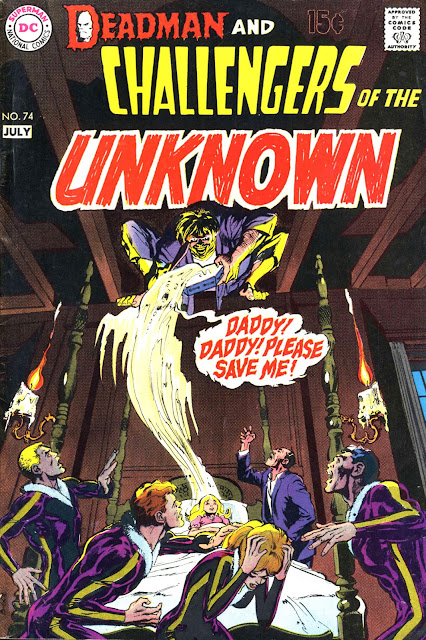Unexpected #119 July 1970
A grasping hand, eerily lit by a stumpy candle, clings to the shoulder of a terrified looking man. It is a moment before the moment of truth, as he slowly turns to face the horror suggested by the grotesque shadow on the ceiling... "I granted your wish... Cured your BLINDNESS! Now turn around and look at WHAT you promised to love and marry!"
This is UNEXPECTED #119, dated July 1970 but on sale several months earlier, one of several Horror anthology titles released by DC and sold for 15 cents. The contents are pretty generous, not only are there three main tales, there are also two shorts making a total of 26 story pages altogether.
The first story is MIRROR MIRROR ON THE WALL, WHO'S THE DEADLIEST OF ALL? Despite effectively atmospheric art from an uncredited Bernie Wrightson and its central concept of a mirror that reflects back previous events, this is perhaps the weakest of the three main stories in this issue. That's not to say it's a bad story in itself, but the narrative becomes too convoluted for what should be a much more economical story-telling format. And what's with those absurd Scottish names... Angus MacTavish and Hamish MacFarland...?
Next comes THE SWAMPCHILD! Written by Carl Wessler, with art cryptically credited to Werner Roth '& friend'... (in actuality Frank Giacoia)
The story opens with a scientist digging about in a swamp before switching to his lab where he grows some of the "primordial gunk" he has dug up into a baby.
As you might expect, things don't go so well once the child grows to adulthood. The ending is particularly disturbing (spoiler alert) as the 'swampchild' is gunned down on her wedding day and 'reverts to a greyish, gelatinous mass... of swamp muck' The image of the wedding dress lying on the ground with the 'pulsating mass' oozing from it is the stuff of pure nightmares, full-marks to the artist for including the gloves, empty stockings and lifeless discarded shoes. This one really haunts me.
Follow @top_notch_tosh on Twitter!Thirdly RACHEL ISN'T READY TO DIE! is the cover story written by George Kashdan and illustrated by Sid Greene & Vince Colletta. It starts beautifully in the dead of night with the silhouetted forms of angry villagers approaching the home of a witch, also seen (with her cat) in outline against the window and descending the crooked staircase lit by a single candle.
The three opening panels are a wonderful evocation of time, place and mood. They contrast impressively with the following sequence which shifts to daylight and the attempted lynching of the witch.
There is a wonderful panel cutting from this sequence back to the witch's home when she escapes accompanied by a blind young man who'd stood up for her at the lynching: the couple are framed in the doorway, again the artist employing silhouette to heighten the mood.
The twisted 'dutch-angle' of the frame and the curve he puts on the shape of the opened door give the image an unsettling momentum which propel the reader into the final pages.
The spell-casting, again with black cat in attendance, is daubed in other-worldly nauseous green and the moment in which the crone makes contact with Myles' blind eyes is spectacularly disturbing.
The (spoiler alert) happy-ever-after ending is actually something of an anti-climax after the preceding horrors, or maybe that's just me wanting to see an added twist in which the now reformed witch is carted off by the ignorant villagers intent on finishing the job of lynching her.
Of the two short short stories, the first REST IN PIECES, an uncredited single-page quickie really amused me. Art is by Murphy Anderson, but the writer is a mystery. The story's brevity belies quite an insightful tale which should act as a warning to anyone who takes something in their life too seriously. I won't spoil it but suggest you read it in its entirety. It's pretty much perfect condensed story-telling.
The last tale, A PHANTOM IN THE TREE, sadly, is something of a 'So what?' story for me. Scripted by 'Al Case' (Murray Boltinoff) with art by Jerry Grandenetti this suffers from an uneven narrative that tries to be poignant and heartfelt but perhaps needed an additional page (it only gets two) to fully develop its concept - the ending seems particularly compromised by the lack of room from development.
That said, a story published in 1970 about a soldier facing death in Vietnam coupled with a rumination on his relationship with his now dead father would have resonated differently with readers at the time.
















Comments
Post a Comment